当前位置:网站首页>c语言指针深入理解
c语言指针深入理解
2022-07-05 09:10:00 【不秃头的萧哥】
文章目录
前言
指针是c语言中较难理解的知识点了,也非常重要,今天我们就来一起深入理解指针吧
一、指针的概念
- 指针就是个地址,地址唯一标识一块内存空间。(常说的指针指的是指针变量)
- 指针的大小是固定的4/8个字节(32位平台/64位平台)。
- 指针是有类型,指针的类型决定了指针的±整数的步长,指针解引用操作的时候的权限。
- 指针的运算:指针相减为两指针之间的元素个数,指针+整数为指针
二、字符指针
在指针的类型中我们知道有一种指针类型为字符指针 char*
一般使用:
int main()
{
char ch = 'w';
char *pc = &ch;
*pc = 'w';
return 0;
}
还有一种使用方式如下:
int main()
{
const char* pstr = "hello bit.";//这里是把一个字符串放到pstr指针变量里了吗?
printf("%s\n", pstr);
return 0;
}
代码 const char* pstr = "hello bit."特别容易让人以为是把字符串 hello bit 放到字符指针 pstr 里了,但是本质是把字符串 hello bit. 首字符的地址放到了pstr中。
有这样一道面试题:
#include <stdio.h>
int main()
{
char str1[] = "hello bit.";
char str2[] = "hello bit.";
const char *str3 = "hello bit.";
const char *str4 = "hello bit.";
if(str1 ==str2)
printf("str1 and str2 are same\n");
else
printf("str1 and str2 are not same\n");
if(str3 ==str4)
printf("str3 and str4 are same\n");
else
printf("str3 and str4 are not same\n");
return 0;
}
输出结果是:
这里str3和str4指向的是一个同一个常量字符串。C/C++会把常量字符串存储到单独的一个内存区域,当几个指针。指向同一个字符串的时候,他们实际会指向同一块内存。但是用相同的常量字符串去初始化
不同的数组的时候就会开辟出不同的内存块。所以str1和str2不同,str3和str4不同。
二、指针数组
指针数组顾名思义就是存放指针的数组
int* arr1[10]; //整形指针的数组
char *arr2[4]; //一级字符指针的数组
char **arr3[5];//二级字符指针的数组
三、数组指针
1.数组指针的定义
数组指针顾名思义就是指向数组的指针
int *p1[10];
int (*p2)[10];
//p1, p2分别是什么?
int (*p)[10];
//
//
解释:p先和*结合,说明p是一个指针变量,然后指着指向的是一个大小为10个整型的数组。所以p是一个指针,指向一个数组,叫数组指针。
这里要注意:[]的优先级要高于*号的,所以必须加上()来保证p先和*结合。
2. &数组名和数组名
对于下面的数组:
int arr[10];
arr 和 &arr 分别是啥?
我们知道arr是数组名,数组名表示数组首元素的地址。
那&arr数组名到底是啥?
我们看一段代码:
#include <stdio.h>
int main()
{
int arr[10] = {
0};
printf("%p\n", arr);
printf("%p\n", &arr);
return 0;
}
运行结果如下: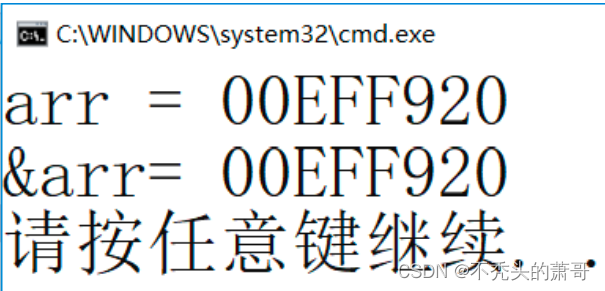
可见数组名和&数组名打印的地址是一样的。
难道两个是一样的吗?
我们再看一段代码:
#include <stdio.h>
int main()
{
int arr[10] = {
0 };
printf("arr = %p\n", arr);
printf("&arr= %p\n", &arr);
printf("arr+1 = %p\n", arr+1);
printf("&arr+1= %p\n", &arr+1);
return 0;
}
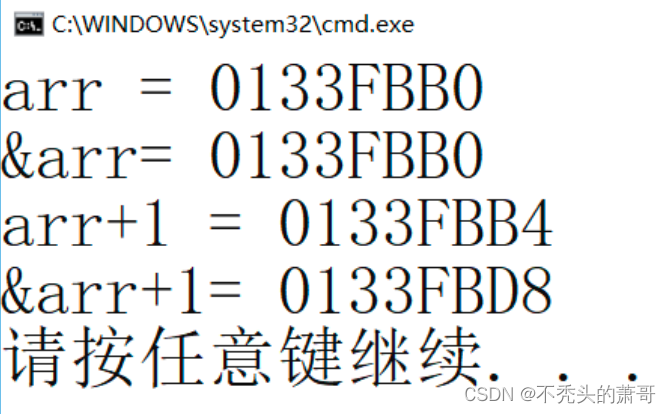
根据上面的代码我们发现,其实&arr和arr,虽然值是一样的,但是意义应该不一样的。
实际上: &arr 表示的是数组的地址,而不是数组首元素的地址。
本例中 &arr 的类型是: int(*)[10] ,是一种数组指针类型
数组的地址+1,跳过整个数组的大小,所以 &arr+1 相对于 &arr 的差值是40
3. 数组指针的使用
那数组指针是怎么使用的呢?
既然数组指针指向的是数组,那数组指针中存放的应该是数组的地址。
看代码:
#include <stdio.h>
int main()
{
int arr[10] = {
1,2,3,4,5,6,7,8,9,0};
int (*p)[10] = &arr;//把数组arr的地址赋值给数组指针变量p
//但是我们一般很少这样写代码
return 0
}
在二维数组传参时,就可以将参数设置为数组指针的形式
四、数组参数、指针参数
在写代码的时候难免要把【数组】或者【指针】传给函数,那函数的参数该如何设计呢?
1. 一维数组传参
#include <stdio.h>
void test(int arr[])
{
}
void test(int arr[10])
{
}
void test(int *arr)
{
}
void test2(int *arr[20])
{
}
void test2(int **arr)
{
}
int main()
{
int arr[10] = {
0};
int *arr2[20] = {
0};
test(arr);
test2(arr2);
}
2. 二维数组传参
void test(int arr[3][5])
{
}
void test(int arr[][5])
{
}
void test(int (*arr)[5])
{
}
int main()
{
int arr[3][5] = {
0};
test(arr);
}
五、 函数指针
首先看一段代码:
#include <stdio.h>
void test()
{
printf("hehe\n");
}
int main()
{
printf("%p\n", test);
printf("%p\n", &test);
return 0;
}
输出的结果:
输出的是两个地址,这两个地址是 test 函数的地址。
那我们的函数的地址要想保存起来,怎么保存?
下面我们看代码:
void test()
{
printf("hehe\n");
}
//下面pfun1和pfun2哪个有能力存放test函数的地址?
void (*pfun1)();
void *pfun2();
pfun1可以存放。pfun1先和*结合,说明pfun1是指针,指针指向的是一个函数,指向的函数无参数,返回值类型为void。
阅读两段有趣的代码:
//代码1
(*(void (*)())0)();
//代码2
void (*signal(int , void(*)(int)))(int);
这两个代码来源于《c陷阱和缺陷》
代码1:
(void(*)( ) )在0的前面,函数指针类型就是void(*)( ),
由此可知,这个是将0强制类型转换成函数指针,并解引用
代码2:
将代码2简化一下就较为清晰了
typedef void(*pfun_t)(int);
pfun_t signal(int, pfun_t);
六、 函数指针数组
数组是一个存放相同类型数据的存储空间,那我们已经学习了指针数组,
比如:
int *arr[10];
//数组的每个元素是int*
那要把函数的地址存到一个数组中,那这个数组就叫函数指针数组,那函数指针的数组如何定义呢?
int (*parr1[10])();
int *parr2[10]();
int (*)() parr3[10];
答案是:parr1
parr1 先和 [] 结合,说明 parr1是数组,数组的内容是什么呢?
是 int (*)() 类型的函数指针。
七、指向函数指针数组的指针
指向函数指针数组的指针是一个指针
指针指向一个数组 ,数组的元素都是函数指针 ;
如何定义?
void test(const char* str)
{
printf("%s\n", str);
}
int main()
{
//函数指针pfun
void (*pfun)(const char*) = test;
//函数指针的数组pfunArr
void (*pfunArr[5])(const char* str);
pfunArr[0] = test;
//指向函数指针数组pfunArr的指针ppfunArr
void (*(*ppfunArr)[5])(const char*) = &pfunArr;
return 0;
}
八、 回调函数
回调函数就是一个通过函数指针调用的函数。如果你把函数的指针(地址)作为参数传递给另一个函数,当这个指针被用来调用其所指向的函数时,我们就说这是回调函数。回调函数不是由该函数的实现方直接调用,而是在特定的事件或条件发生时由另外的一方调用的,用于对该事件或条件进行响应。
首先演示一下qsort函数的使用:
#include <stdio.h>
//qosrt函数的使用者得实现一个比较函数
int int_cmp(const void * p1, const void * p2)
{
return (*( int *)p1 - *(int *) p2);
}
int main()
{
int arr[] = {
1, 3, 5, 7, 9, 2, 4, 6, 8, 0 };
int i = 0;
qsort(arr, sizeof(arr) / sizeof(arr[0]), sizeof (int), int_cmp);
for (i = 0; i< sizeof(arr) / sizeof(arr[0]); i++)
{
printf( "%d ", arr[i]);
}
printf("\n");
return 0;
}
使用回调函数,模拟实现qsort(采用冒泡的方式)。
#include <stdio.h>
int int_cmp(const void * p1, const void * p2)
{
return (*( int *)p1 - *(int *) p2);
}
void _swap(void *p1, void * p2, int size)
{
int i = 0;
for (i = 0; i< size; i++)
{
char tmp = *((char *)p1 + i);
*(( char *)p1 + i) = *((char *) p2 + i);
*(( char *)p2 + i) = tmp;
}
}
void bubble(void *base, int count , int size, int(*cmp )(void *, void *))
{
int i = 0;
int j = 0;
for (i = 0; i< count - 1; i++)
{
for (j = 0; j<count-i-1; j++)
{
if (cmp ((char *) base + j*size , (char *)base + (j + 1)*size) > 0)
{
_swap(( char *)base + j*size, (char *)base + (j + 1)*size, size);
}
}
}
}
int main()
{
int arr[] = {
1, 3, 5, 7, 9, 2, 4, 6, 8, 0 };
//char *arr[] = {"aaaa","dddd","cccc","bbbb"};
int i = 0;
bubble(arr, sizeof(arr) / sizeof(arr[0]), sizeof (int), int_cmp);
for (i = 0; i< sizeof(arr) / sizeof(arr[0]); i++)
{
printf( "%d ", arr[i]);
}
printf("\n");
return 0;
}
结语
今天我们深入了解了c语言指针的一些相关概念,下一次我将用一些题目来加深对指针的理解。
每天学一点,时间久了,菜鸟也能变成大神
边栏推荐
- Jenkins Pipeline 方法(函数)定义及调用
- Wechat H5 official account to get openid climbing account
- 利用请求头开发多端应用
- ECMAScript6介绍及环境搭建
- MPSoC QSPI flash upgrade method
- [daiy4] copy of JZ35 complex linked list
- Summary of "reversal" problem in challenge Programming Competition
- AUTOSAR from getting started to mastering 100 lectures (103) -dbc file format and creation details
- Introduction Guide to stereo vision (3): Zhang calibration method of camera calibration [ultra detailed and worthy of collection]
- . Net service governance flow limiting middleware -fireflysoft RateLimit
猜你喜欢
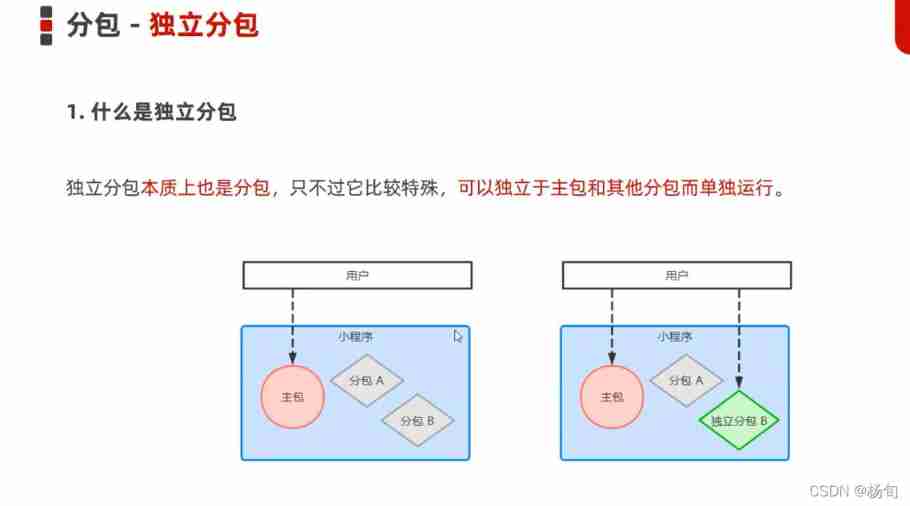
Applet (subcontracting)
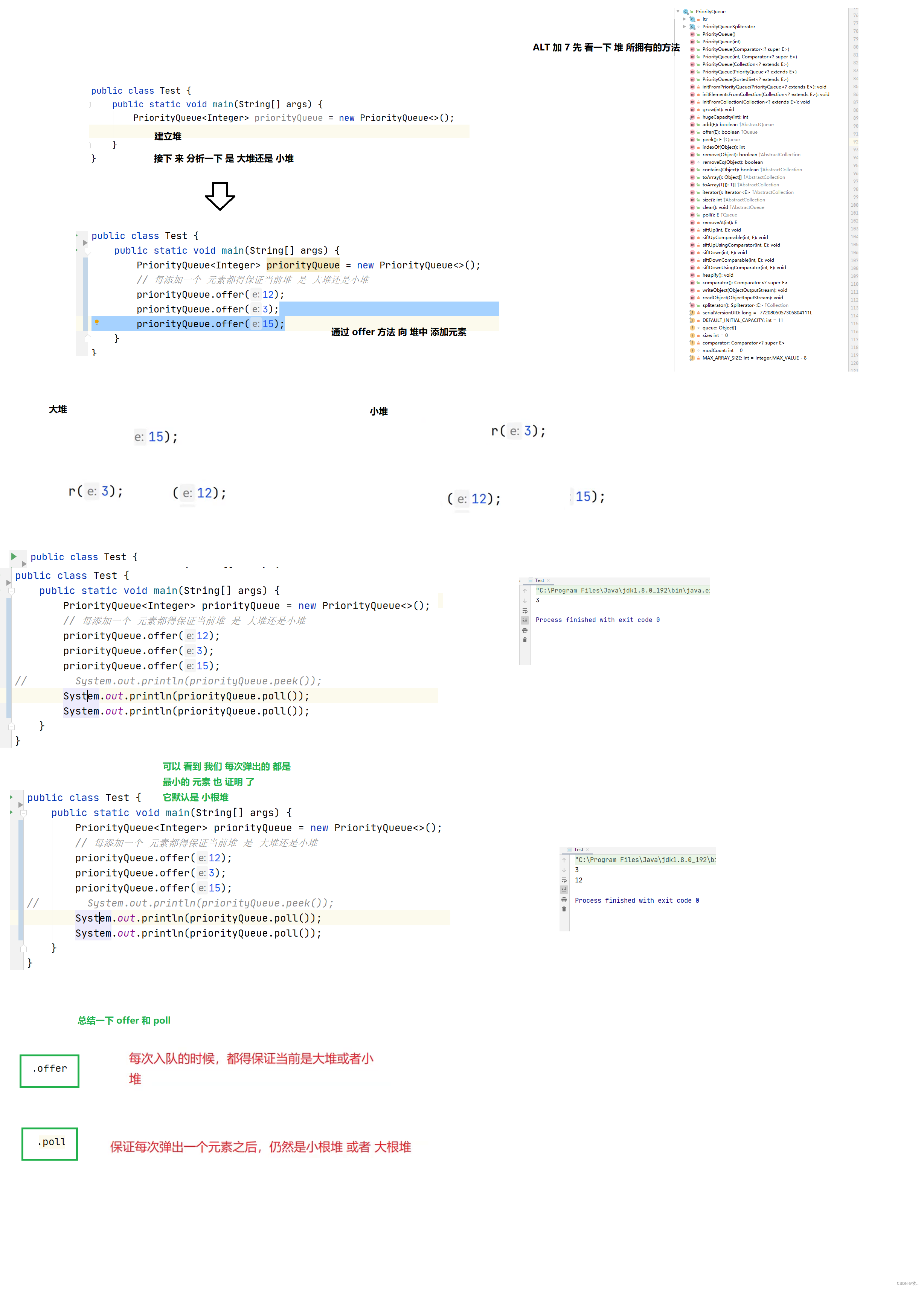
Priority queue (heap)

优先级队列(堆)
![C [essential skills] use of configurationmanager class (use of file app.config)](/img/8b/e56f87c2d0fbbb1251ec01b99204a1.png)
C [essential skills] use of configurationmanager class (use of file app.config)
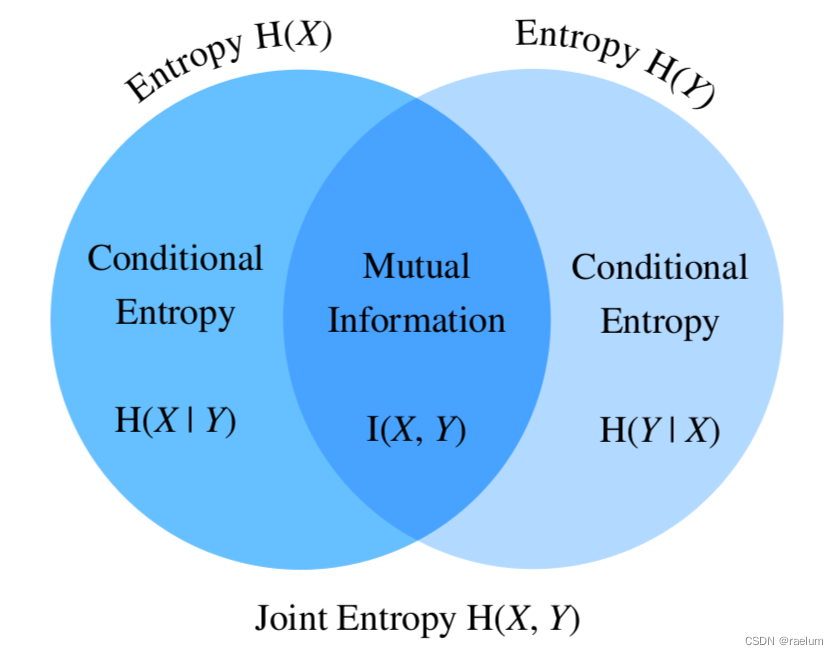
信息与熵,你想知道的都在这里了
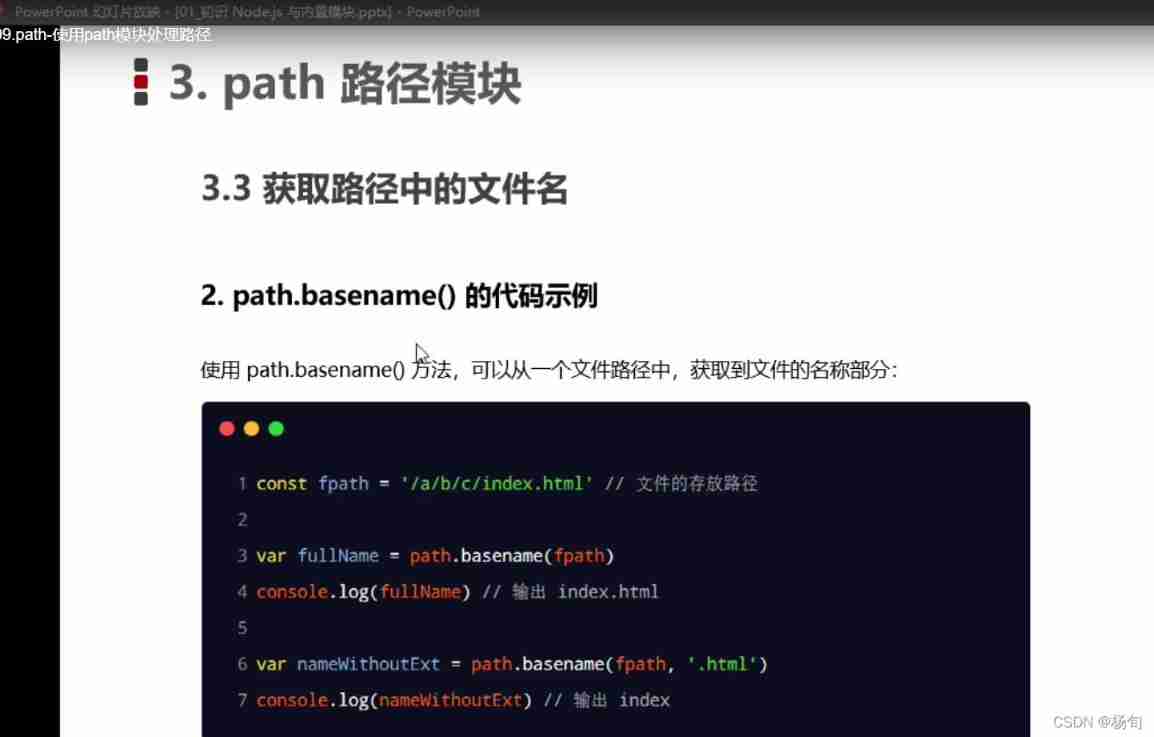
fs. Path module

Count of C # LINQ source code analysis

Solution to the problems of the 17th Zhejiang University City College Program Design Competition (synchronized competition)
![[code practice] [stereo matching series] Classic ad census: (4) cross domain cost aggregation](/img/d8/7291a5b14160600ba73810e6dd1eb5.jpg)
[code practice] [stereo matching series] Classic ad census: (4) cross domain cost aggregation
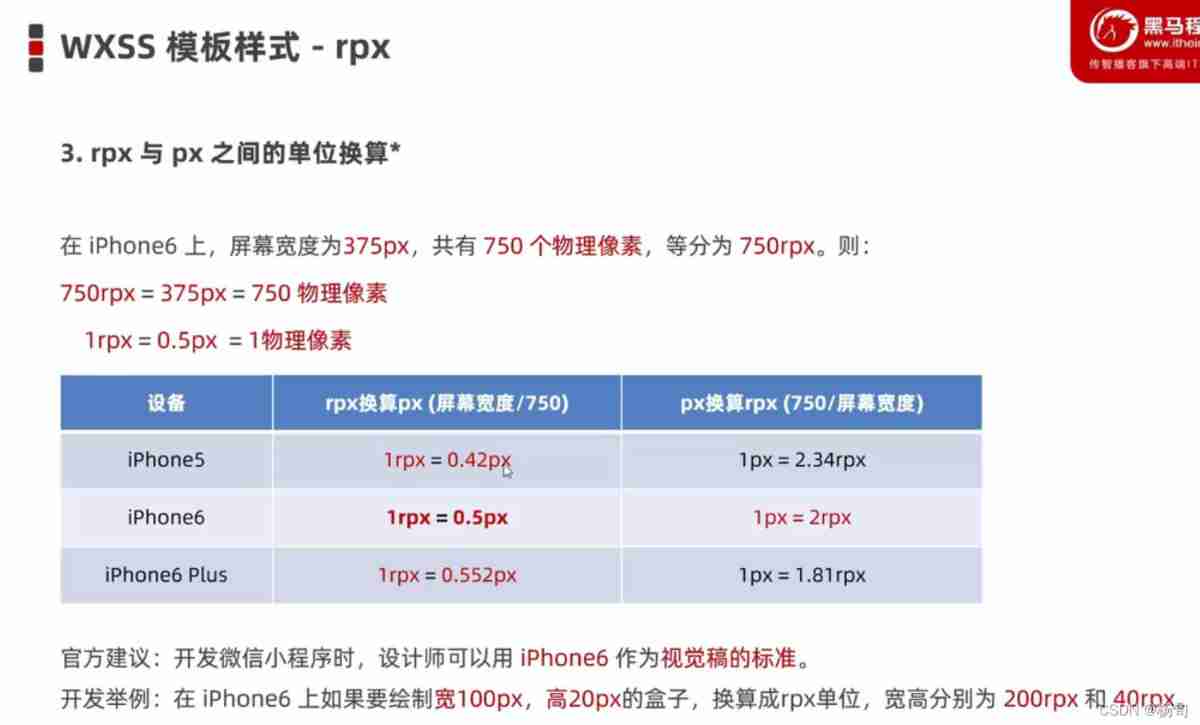
Wxss template syntax
随机推荐
notepad++
2311. Longest binary subsequence less than or equal to K
.NET服务治理之限流中间件-FireflySoft.RateLimit
Blue Bridge Cup provincial match simulation question 9 (MST)
阿里云发送短信验证码
Configuration and startup of kubedm series-02-kubelet
信息與熵,你想知道的都在這裏了
AUTOSAR from getting started to mastering 100 lectures (103) -dbc file format and creation details
C # compare the differences between the two images
Install the CPU version of tensorflow+cuda+cudnn (ultra detailed)
How many checks does kubedm series-01-preflight have
太不好用了,长文章加图文,今后只写小短文
[technical school] spatial accuracy of binocular stereo vision system: accurate quantitative analysis
Driver's license physical examination hospital (114-2 hang up the corresponding hospital driver physical examination)
scipy. misc. imread()
Array, date, string object method
C#图像差异对比:图像相减(指针法、高速)
Ministry of transport and Ministry of Education: widely carry out water traffic safety publicity and drowning prevention safety reminders
Mengxin summary of LCs (longest identical subsequence) topics
TF coordinate transformation of common components of ros-9 ROS